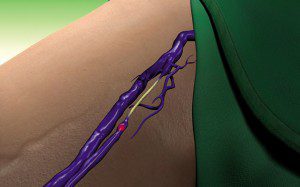By Joseph Magnant, MD, FACS, RPVI
 Venous insufficiency, or leaky veins, is a medical disease that, if left untreated, can lead to long-term health problems. Yet, it can be easily evaluated and often remedied permanently through a minimally invasive procedure.
Venous insufficiency, or leaky veins, is a medical disease that, if left untreated, can lead to long-term health problems. Yet, it can be easily evaluated and often remedied permanently through a minimally invasive procedure.
Lesley Colantonio says she had significant varicose veins.
“I thought they looked really nasty,” remembers the 41-year-old senior special events coordinator for Make-A-Wish Foundation of Southern Florida and mother of three. “I just had a little spot on the back of my left leg, but I had more on my right leg and a giant one on the inside of my right knee. I’m extremely fair skinned, so they stuck out like a sore thumb. I asked my primary health provider about them, but she advised me that it was a cosmetic issue and that treatment would cost me a fortune.”
Disappointed, but not ready to give up, Lesley says she took advantage of an opportunity that presented itself: “I was covering a booth at a senior expo and happened to notice the display of a vascular surgeon. Just for my own piece of mind, I approached the surgeon’s representative.”
That encounter led Lesley to schedule an appointment with Joseph G. Magnant, MD, FACS, a board-certified vascular surgeon who specializes in vein treatment. His practice, Vein Specialists, with offices in Fort Myers and Bonita Springs, is 100% dedicated to the modern evaluation and treatment of leg vein disorders.
“We rely heavily on ultrasound evaluation of our patients’ veins,” explains Dr. Magnant.
A diagnostic ultrasound is a very conservative, noninvasive, accurate, diagnostic tool that can be used to identify any leaking veins.
“With ultrasound, which is usually covered by patients’ health insurance, we can determine the exact source of the problem,” says Magnant. “We can see exactly which veins are leaking, stratify the degree and length of veins involved and then design a game plan to solve the problem.”
Dr. Magnant had his vascular technologist J.T. Jarrard perform a full ultrasound on each of Lesley’s legs. The ultrasound revealed that both of her legs had severe superficial venous insufficiency, which is a condition in which the valves of the superficial veins of the lower extremities no longer function properly in a one-way manner. These valves are floppy and continue to open, or prolapse, beyond the closed position. This results in reflux, or backward blood flow in the veins, which produces increased hydrostatic pressure in the venous system leading to bulging or varicose veins, swollen legs and other signs or symptoms of vein disease.
Superficial venous insufficiency affects between 35 and 40 million adults in the US, says Dr. Magnant: “It is a correctable medical disease. There are modern techniques to both diagnose and treat it, but if left untreated, it can lead to many unhealthy symptoms. Venous insufficiency should be treated more as a medical condition than a cosmetic condition since leaving it alone often results in more serious conditions.”
A reasonable answer for patients suffering with any of these symptoms is to have a complete evaluation by a board-certified vein specialist which will usually include a diagnostic leg ultrasound.
Radiofrequency and EVLT endovenous closure
Historically, the only treatment available to offer patients with venous insufficiency was surgical vein excisions or vein stripping, which often required hospitalization and general anesthesia along with an extended recovery period.
“Because the surgery was so invasive, unless the patient had bleeding or ulcers, patient management usually meant compression stockings,” remembers Dr. Magnant.
“Fortunately, leaky superficial veins can be treated today with a choice of minimally invasive, in-office procedures. In 1999, the first FDA-approved system was the radiofrequency-based closure system designed by VNUS Medical Technologies, now called the ClosureFAST or Venefit. Using a catheter-based system, the vein is heated, under local anesthesia, in the sterile office setting and closed segmentally from the inside.
“It was really a game changer in terms of treating patients with venous disease.”
Then, in 2001, the first laser-based system was approved, and other laser companies followed suit with various wavelengths, says Dr. Magnant: “This procedure is often referred to as endovenous laser treatment, or EVLT, and is slightly different in technique from radiofrequency in that it is a LASER catheter which is used which heats at the very tip and is retracted continuously rather than segmentally.
“Vein Specialists offer both the newer VNUS ClosureFAST system and Cooltouch LASER for EVLT, because each system has its place in the treatment of patients with venous disease. In fact, for Lesley we used the ClosureFAST on her right leg where the veins were long, straight, and deep, and we used the laser on her left leg where the veins were smaller and shorter in length.
“Both the VNUS and laser systems allow us to treat patients in the office without anesthesia risks, and patients can return to normal activities almost immediately.”
Lesley was pleased to learn that her insurance company would cover the cost of both treatments.
“My legs look fantastic,” says Lesley, “and the restlessness I was experiencing in my legs stopped entirely.
“Dr. Magnant and his staff are true professionals, and terrific to work with; they’re great people. In fact, the doctor was kind enough to buy a table at one of our biggest fundraisers: the Wishmaker’s Ball, and he and some of his guests adopted wishes for a child.”
Dr. Magnant continues to support Make a Wish Foundation and recently he nominated one of his patient’s children and both were recipients of a wish this year!
Consider Venous Insufficiency earlier in the course of the disease
Not everyone with venous insufficiency has obvious varicose veins sticking out, stresses Dr. Magnant: “Approximately half of our patients have bulging veins, but the other half present with less obvious external signs and more obscure symptoms.
“Venous insufficiency is a medical disease and, like for any disease, early diagnosis is beneficial. We don’t advise waiting for a heart attack or stroke to treat high cholesterol, nor do we suggest waiting for vision problems or circulation problems to treat diabetes. It makes no more sense to wait for a deep vein clot, skin changes, bleeding or ulceration to treat venous insufficiency.”
“I’ve recommended Dr. Magnant to several people, including my own mom,” reflects Lesley. “He’s fabulous.”
239-694-VEIN (8346)
1510 Royal Palm Square Blvd., Suite 101, Fort Myers, Florida | 3359 Woods Edge Circle, Suite 102, Bonita Springs, Florida









